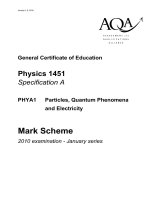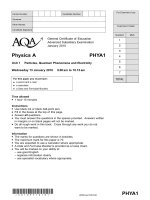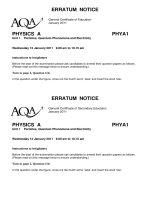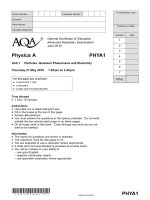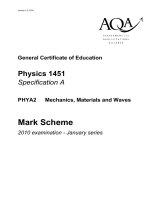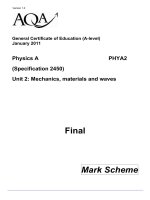- Trang chủ >>
- Khoa Học Tự Nhiên >>
- Vật lý
Vật lý A level: AQA PHYA4 w MS JAN11
Bạn đang xem bản rút gọn của tài liệu. Xem và tải ngay bản đầy đủ của tài liệu tại đây (195.09 KB, 8 trang )
Version 1.0
General Certificate of Education (A-level)
January 2011
Physics A
(Specification 2450)
PHYA4
Unit 4: Fields and further mechanics
Final
Mark Scheme
Mark schemes are prepared by the Principal Examiner and considered, together with the relevant
questions, by a panel of subject teachers. This mark scheme includes any amendments made at the
standardisation events which all examiners participate in and is the scheme which was used by them
in this examination. The standardisation process ensures that the mark scheme covers the
candidates’ responses to questions and that every examiner understands and applies it in the same
correct way. As preparation for standardisation each examiner analyses a number of candidates’
scripts: alternative answers not already covered by the mark scheme are discussed and legislated for.
If, after the standardisation process, examiners encounter unusual answers which have not been
raised they are required to refer these to the Principal Examiner.
It must be stressed that a mark scheme is a working document, in many cases further developed and
expanded on the basis of candidates’ reactions to a particular paper. Assumptions about future mark
schemes on the basis of one year’s document should be avoided; whilst the guiding principles of
assessment remain constant, details will change, depending on the content of a particular examination
paper.
Further copies of this Mark Scheme are available from: aqa.org.uk
Copyright © 2011 AQA and its licensors. All rights reserved.
Copyright
AQA retains the copyright on all its publications. However, registered centres for AQA are permitted to copy material from this
booklet for their own internal use, with the following important exception: AQA cannot give permission to centres to photocopy
any material that is acknowledged to a third party even for internal use within the centre.
Set and published by the Assessment and Qualifications Alliance.
The Assessment and Qualifications Alliance (AQA) is a company limited by guarantee registered in England and Wales (company number 3644723) and a registered
charity (registered charity number 1073334).
Registered address: AQA, Devas Street, Manchester M15 6EX.
Mark Scheme – General Certificate of Education (A-level) Physics A – Unit 4: Fields and further
mechanics – January 2011
3
Instructions to Examiners
1 Give due credit for alternative treatments which are correct. Give marks for what is correct in
accordance with the mark scheme; do not deduct marks because the attempt falls short of
some ideal answer. Where marks are to be deducted for particular errors, specific instructions
are given in the marking scheme.
2 Do not deduct marks for poor written communication. Refer the scripts to the Awards meeting
if poor presentation forbids a proper assessment. In each paper, candidates are assessed on
their quality of written communication (QWC) in designated questions (or part-questions) that
require explanations or descriptions. The criteria for the award of marks on each such
question are set out in the mark scheme in three bands in the following format. The descriptor
for each band sets out the expected level of the quality of written communication of physics for
each band. Such quality covers the scope (eg relevance, correctness), sequence and
presentation of the answer. Amplification of the level of physics expected in a good answer is
set out in the last row of the table. To arrive at the mark for a candidate, their work should first
be assessed holistically (ie in terms of scope, sequence and presentation) to determine which
band is appropriate then in terms of the degree to which the candidate’s work meets the
expected level for the band.
QWC descriptor mark range
Good - Excellent
see specific mark scheme 5 – 6
Modest - Adequate
see specific mark scheme 3 – 4
Poor - Limited
see specific mark scheme 1 – 2
The description and/or explanation expected in a good answer should include a
coherent account of the following points:
see specific mark scheme
Answers given as bullet points should be considered in the above terms. Such answers
without an ‘overview’ paragraph in the answer would be unlikely to score in the top band.
3 An arithmetical error in an answer will cause the candidate to lose one mark and should be
annotated AE if possible. The candidate’s incorrect value should be carried through all
subsequent calculations for the question and, if there are no subsequent errors, the candidate
can score all remaining marks.
4 The use of significant figures is tested once on each paper in a designated question or part-
question. The numerical answer on the designated question should be given to the same
number of significant figures as there are in the data given in the question or to one more than
this number. All other numerical answers should not be considered in terms of significant
figures.
5 Numerical answers presented in non-standard form are undesirable but should not be
penalised. Arithmetical errors by candidates resulting from use of non-standard form in a
candidate’s working should be penalised as in point 3 above. Incorrect numerical prefixes and
the use of a given diameter in a geometrical formula as the radius should be treated as
arithmetical errors.
6 Knowledge of units is tested on designated questions or parts of questions in each a paper.
On each such question or part-question, unless otherwise stated in the mark scheme, the
mark scheme will show a mark to be awarded for the numerical value of the answer and a
further mark for the correct unit. No penalties are imposed for incorrect or omitted units at
intermediate stages in a calculation or at the final stage of a non-designated ‘unit’ question.
7 All other procedures including recording of marks and dealing with missing parts of answers
will be clarified in the standardising procedures.
Mark Scheme – General Certificate of Education (A-level) Physics A – Unit 4: Fields and further
mechanics – January 2011
4
GCE Physics, Specification A, PHYA4, Fields and Further Mechanics
Section A
This component is an objective test for which the following list indicates the correct answers used in
marking the candidates’ responses.
Keys to Objective Test Questions
1 2 3 4 5 6 7 8 9 10 11 12 13
B A C D C C C B D B B A D
14 15 16 17 18 19 20 21 22 23 24 25
D C C A A D B B D A A C
Section B
Question 1
(a)
ω
!
"
#$
%
&
"
#$
'( ) *+
! [or ω
!
"
,*+
%
&
"
,*+
'( ) *+
]
3
= 1.1 × 10
–3
(1.08 × 10
–3
) ! [= 6.2 (6.19) × 10
–2
]
rad s
–1
[accept s
–1
] ! [degree s
–1
]
(b) (i)
/
0
1
= mω
2
r or r
3
=
2
1
!
3
gives r
3
=
*.*( ) 3+
455
) 6.'7 ) 3+
18
93.+7 ) 3+
4:
;
1
!
∴ r = 6.99 × 10
6
(m) !
(b) (ii) F (= mω
2
r) = 1.1 × 10
4
× (1.08 × 10
–3
)
2
× 6.99 × 10
6
!
2
= 9.0 × 10
4
(8.97 × 10
4
) (N) !
[or F
!
"
/
0
1
&
"
*.*( ) 3+
455
) 6.'7 ) 3+
18
) 3.3) 3+
8
9*.'' ) 3+
<
;
1
!
= 9.0 × 10
4
(8.98 × 10
4
) (N) !]
Total 8
Mark Scheme – General Certificate of Education (A-level) Physics A – Unit 4: Fields and further
mechanics – January 2011
5
Question 2
(a) force = rate of change of momentum !
1
(b) (i) area under graph represents impulse or change in momentum !
1
(b) (ii) suitable method to estimate area under graph !!
4
[eg
counting squares: 20 to 23 squares !
each of area 25 × 10
–3
× 20 = 0.5 (N s) !
or approximate triangle etc !
½ × 250 × 10
–3
× 90 !]
gives impulse = 11 ± 1 !
N s (or kg m s
–1
) !
(b) (iii) use of impulse = Δ(mv) !
4
Δp = mv – (– mu) = m (v + u) or 11 = 0.42 (v + 10) !
giving 0.42 v = 6.8 and v = 16 (m s
–1
) (impulse = 12 gives 19 m s
–1
) !
answer to 2 sf only !
(c) final speed would be lower !
3
any two of the following points !!
● initial momentum would be greater [or greater u must be reversed]
●
change in momentum [or velocity] is the same [or larger F acts for
shorter t]
● initial and final momenta are (usually) in opposite directions
●
initial and final momenta may be in same direction if initial speed is
sufficiently high
[alternatively
final speed =
impulse 9from graph;
mass of ball
– initial speed !
gives final speed v = (26 ± 3) – initial speed u !
consequence is
● v is in opposite direction to u when u < 26
● v is in same direction as u when u > 26
● v is zero (ball stationary) when u = 26
any one of these bullet points !]
Total 13
Mark Scheme – General Certificate of Education (A-level) Physics A – Unit 4: Fields and further
mechanics – January 2011
6
Question 3
(a)
The candidate’s writing should be legible and the spelling, punctuation
and grammar should be sufficiently accurate for the meaning to be
clear.
max 6
The candidate’s answer will be assessed holistically. The answer will be
assigned to one of the three levels according to the following criteria.
High Level (good to excellent) 5 or 6 marks
The information conveyed by the answer is clearly organised, logical and
coherent, using appropriate specialist vocabulary correctly. The form and
style of writing is appropriate to answer the question.
The candidate provides a comprehensive and logical description of the
sequence of releasing the ball and taking measurements of initial and final
voltages. They should identify the correct distance measurement and show
a good appreciation of how to use these measurements to calculate the
time and acceleration from them. Time should be found from capacitor
discharge, using known C and R values. Repeated readings would be
expected in any answer worthy of full marks, but five marks may be
awarded where repetition is omitted.
Intermediate Level (modest to adequate) 3 or 4 marks
The information conveyed by the answer may be less well organised and
not fully coherent. There is less use of specialist vocabulary, or specialist
vocabulary may be used incorrectly. The form and style of writing is less
appropriate.
The candidate provides a comprehensive and logical description of the
sequence of releasing the ball and taking measurements of the initial and
final voltages. They are likely to show some appreciation of the use of suvat
equations to calculate the acceleration, although they may not recognise the
need to measure a distance.
Low Level (poor to limited) 1 or 2 marks
The information conveyed by the answer is poorly organised and may not
be relevant or coherent. There is little correct use of specialist vocabulary.
The form and style of writing may only be partly appropriate.
The candidate is likely to have recognised that initial and final voltages
should be measured, but may not appreciate the need for any other
measurement. They may present few details of how to calculate the
acceleration from the voltage measurements.
The explanation expected in a competent answer should include a
coherent selection of the following points.
Measurements
● initial pd across C (V
0
) from voltmeter (before releasing roller)
● distance s along slope between plungers
● final pd across C (V
1
) from voltmeter
● measurements repeated to provide a more reliable result
Analysis
● time t is found from V
1
= V
0
e
-t/RC
, giving t = RC ln (V
0
/V
1
)
● from s = ut + ½ at
2
with u = 0, acceleration a = 2s/t
2
● repeat and find average a from several results
Mark Scheme – General Certificate of Education (A-level) Physics A – Unit 4: Fields and further
mechanics – January 2011
7
(b) (i) RC = 22 × 10
–6
× 200 × 10
3
[or = 4.4 (s)] ! (4.40)
3
5.8 = 12.0 e
–t/4.40
!
gives t = 4.40 ln (12.0/5.8) = 3.2 (3.20) (s) !
(b) (ii)
a
!
"
#=
>
1
&
"
# ) #.6
,.#+
1
!
2
= 0.49 (0.488) (m s
–2
) !
Total 11
Question 4
(a) (i)
E
!
"
?
@
&
"
*++
7+ ) 3+
4:
!
2
= 7.5 × 10
3
(V m
–1
) !
(a) (ii) force F (= EQ) = 7500 × 0.17 × 10
–6
! (= 1.28 × 10
–3
N)
1
(b) (i) correct labelled arrows placed on diagram to show the three forces acting;
2
● electric force F (or 1.3 mN) horizontally to left !
● W (or mg) vertically down and
● tension T upwards along the thread !
(b) (ii)
F = T sinθ and mg = T cosθ give F = mg tanθ ! (or by triangle or
parallelogram methods)
3
tanθ
!
"
A
/B
&
"
3.#7 ) 3+
4:
C.7 ) 3+
48
) '.73
(= 0.272) !
gives θ = 15(.2) (°) !
Total 8
Mark Scheme – General Certificate of Education (A-level) Physics A – Unit 4: Fields and further
mechanics – January 2011
8
Question 5
(a) (i) (vertically) downwards !
1
(a) (ii)
force F is perpendicular to both B and I [or equivalent correct explanation
using Fleming LHR] !
max 3
magnitude of F changes as size of current changes !
force acts in opposite direction when current reverses [or ac gives
alternating force] !
continual reversal of ac means process is repeated !
(b) appreciation that maximum force corresponds to peak current !
3
peak current = 2.4 )
√
2 = 3.39 (A) !
F
max
(= B I
pk
L) = 0.22 × 3.39 × 55 × 10
–3
! (= 4.10 × 10
–2
N)
(c)
wavelength (λ) of waves
"
!
"
E
F
&
"
*C
7+
= 0.80 (m) !
3
length of wire is λ/2 causing fundamental vibration !
[or λ of waves required for fundamental (= 2 × 0.40) = 0.80 m !
natural frequency of wire
!
"
E
G
&
"
*C
+.7+
= 80 (Hz) !]
wire resonates (at frequency of ac supply) [or a statement that fundamental
frequency (or a natural frequency) of the wire is the same as applied
frequency] !
Total 10
